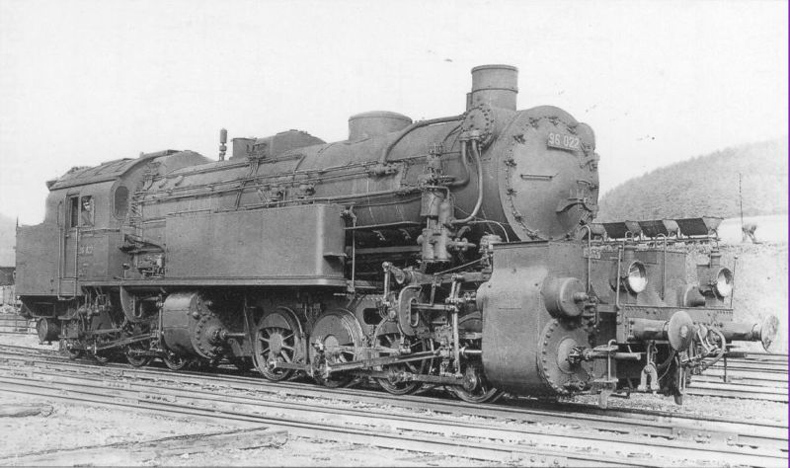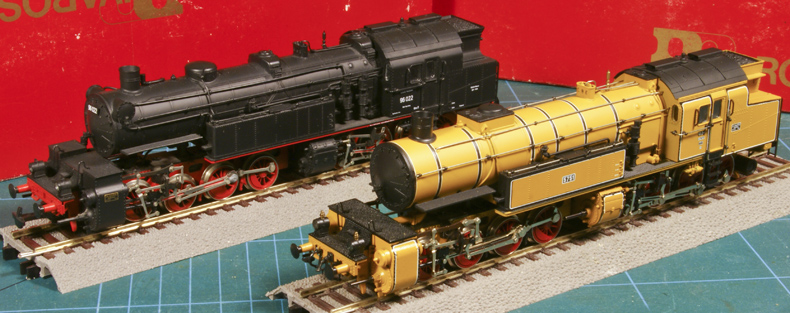Garrattfan's Modelrailroading Pages

My collection
Deutsche Reichsbahn 96 0
Prototype
Like the 98 727 this mallet was also originally built for the Bavarian State Railways. Fifteen engines were built in 1913 as pushers. Their performance was not satisfying, the Prussian fixed frame type T20 delivering more tractive power. The front set of drivers had a tendency to slip and move from left to right. They were reconstructed to ease this. A second batch was built as late as 1922-1923 thereby concluding any production of articulated locomotives for European use. All engines were scrapped by the fifties.

The 98 0 was a unique locomotive in several respects
- To my knowledge this was the only steam locomotive with sixteen drivers in Europe
- and one of the very few of the 0-8-8-0 type anywhere in the world (see other 0-8-8-0)
- and almost certainly the only tank 0-8-8-0 (all other where tender locomotives, like the Erie L1)
Note: these locomotives were true mallets, that is they were compound engines. This can clearly be seen by the different sizes of the sets of cylinders
Model of the second batch (1922-1923)
The model was produced by Rivarossi. It depicts a prototype of the second batch from 1922-1923. I bought the model in 2004. According to the German Model Railroad Wiki this model was produced starting from 1987. It isn't exactly of the latest standard
but it can certainly survive comparison with the much more expensive Märklin
version. I bought this model for €130. Like almost all mallets in model this model is not prototypical in
that respect that both sets of drivers swivel at some point just off center
of each set. A real mallet had the rear set fixed in the frame and only the
front set swiveled at a point between the rear cylinders.
It runs noisily and its slow running capabilities are limited. So here is a good little project to get the loco running nicely and maybe at the time upgrade to higher standard. Some ideas on that include
- refurbisching the loco with a Faulhaber or Maxxon motor
- trimming the oversized running gear, blackening it in the process
- installend smaller headlights
- turning the wheels to RP25 norm and blackening
Model of the first batch (1913)
 |
|
Not long after I bought the black giant a felt a pang of regret that I had not considered buying the "Länderbahn" version, that is: in any livery from before the formation of the Deutsche Reichsbahn. Automatically that would been a version fom the first batch which differs from the second batch in many details. Since then I had been looking for such a version, but that did not turn out to be very easy. Oh yes, they are readily available but usually the complex liveries makes the model pretty pricy. It wasn't on my list of priorities either. In 2015 at the International model railway fair in Arnhem I stumbled upon an ockre version, as originally delivered, for a very good price. The deal was quickly done, and now I have both. This model was produced between 1982 and 1986. Originally I intended to sell the black one once I got the Länderbahn version, but as the versions really differI think they complement each other nicely, so why bother? This loco runs far better than the black version, so the bad running of the latter is probably an individual problem.
|
|
 |
|
The difference is in the detail |
|
 |
 |
Raised cylinder tops
|
|
 |
|
Different sandboxes
|
|
 |
|
One resp. two air pumps
|
|
 |
|
Slanted versus straight rear bunker
|
|
 |
|
Addition of a feedwater heater
|
|
 |
|
All the differences also require numerous differences in the piping arrangements.
|
|
 |
|


Sign my
GuestBook